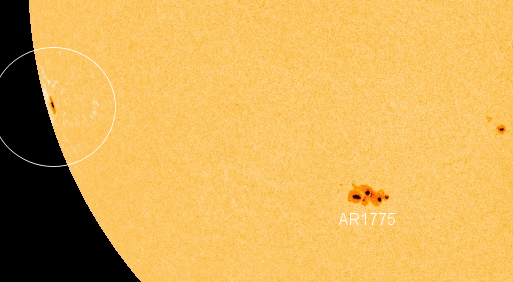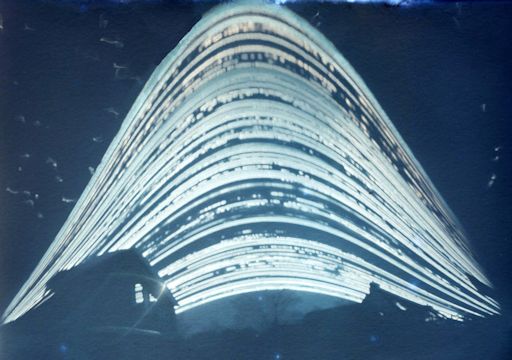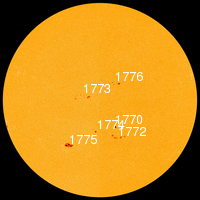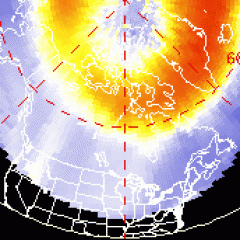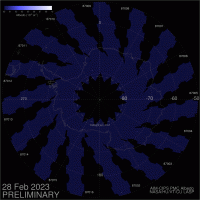MIDSUMMER'S NIGHT: Tonight, June 20-21, is shortest night of the year in the Northern Hemisphere. The northern summer solstice is at 1:04 a.m. on the 21st EDT and 10:04 p.m. on the 20th PDT.
EMERGING ACTIVE REGION: For the past few days, a sunspot group on the farside of the sun has been crackling with flares and propelling CMEs into space. Now, this still-unnumbered active region moving onto the Earthside of the sun. NASA's Solar Dynamics Observatory caught it coming over the eastern limb on June 20th (circled):
By week's end, the emerging sunspot will reveal itself fully to telescopes on Earth. If it has a complex magnetic field that harbors energy for strong eruptions, Earth-directed flares could be in the offing.
Meanwhile, big sunspot AR1775 already poses a threat for Earth-directed flares. It has a 'beta-delta' class magnetic field that poses a threat for M-class eruptions. NOAA forecasters estimate a 30% chance of M-flares on June 20-21. Solar flare alerts: text, voice.
Realtime Space Weather Photo Gallery
SIX MONTHS IN A BEER CAN: The summer solstice is coming, and in the Netherlands that means it's time to open up the beer cans around the Philippus Lansbergen Observatory in Middleberg. It's not what you think! There's no beer inside, only photo paper. Every year, astronomers at the observatory help members of the public make beer-can solargraphs to record the motion of the sun across the sky. Yesterday, after six months in the field, the solargraphs were opened, and this is what they revealed:
"This shows the movement of the Sun with 1 single shot of 6 months exposure time," explains Jan Koeman of the Philippus Lansbergen Observatory. "We deployed the beer-can solargraphs in December and opened them yesterday."
The lowest arcs were traced by the winter sun of Dec. 2012. The highest arc was made by the sun yesterday on the eve of the 2013 summer solstice. Occasional gaps are caused by clouds.
"It seems the sun has been shining a lot the last 6 months," notes Koeman. "This does not match with the general view of cloudy weather in the Netherlands!"
6-month Solargraph How-to Guides: #1, #2, #3

Solar wind
speed: 503.1 km/sec
density: 9.3 protons/cm3
explanation | more data
Updated: Today at 2305 UT
X-ray Solar Flares
6-hr max: C1 2028 UT Jun20
24-hr: C1 0920 UT Jun20
explanation | more data
Updated: Today at: 2300 UT
![]()
Daily Sun: 20 Jun 13
Sunspot AR1775 poses a growing threat for M-class solar flares. Credit: SDO/HMI
![]()
Sunspot number: 126
What is the sunspot number?
Updated 20 Jun 2013
Spotless Days
Current Stretch: 0 days
2013 total: 0 days (0%)
2012 total: 0 days (0%)
2011 total: 2 days (<1%)
2010 total: 51 days (14%)
2009 total: 260 days (71%)
Since 2004: 821 days
Typical Solar Min: 486 days
Update 20 Jun 2013
The Radio Sun
10.7 cm flux: 123 sfu
explanation | more data
Updated 20 Jun 2013
![]()
Current Auroral Oval:
Switch to: Europe, USA, New Zealand, Antarctica
Credit: NOAA/POES
![]()
Planetary K-index
Now: Kp= 4 unsettled
24-hr max: Kp= 4 unsettled
explanation | more data
Interplanetary Mag. Field
Btotal: 10.4 nT
Bz: 5.6 nT south
explanation | more data
Updated: Today at 2307 UT
![]()
Coronal Holes: 20 Jun 13
Solar wind flowing from this coronal hole could brush against Earth's magnetic field on June 22-24. Credit: SDO/AIA.
![]()
NEW: Spaceweather.com is now posting daily satellite images of noctilucent clouds (NLCs), which hover over Earth's poles at the edge of space. The data come from NASA's AIM spacecraft. The north polar "daisy" pictured below is a composite of near-realtime images from AIM assembled by researchers at the University of Colorado's Laboratory for Atmospheric and Space Physics (LASP). |
![]() Noctilucent Clouds
Noctilucent Clouds
Switch view: Europe, USA, Asia, Polar
Updated at: 06-20-2013 13:55:02

